You are here: Foswiki>Dmi Web>SomaliDiaspora (30 Sep 2014, SaskiaKok)Edit Attach
The Geographical Dispersions of the Somali and Rwandan Diaspora
Team Members
Week 1: Anna Berbers, Gabriele Colombo, Saskia Kok, Monia Massarini, Irina Papazu, Richard Rogers, Arnoud Zwemmer. Week 2: Gabriele Colombo, Michiel van der Haagen, Saskia Kok, Richard Rogers.Introduction
According to the literature, the transnational social formation of diaspora groups appears to be enduring and undertake a variety of forms of transnational as well as national activity, shaping both the societies in which diaspora find themselves and their home communities, as well as fostering connections with other diaspora (Van Hear, 2013). Furthermore, diasporas that have merged through conflict-induced displacement can have impacts on the homeland in at least two ways: (1) from abroad, while the diaspora is in exile, by lobbying, sending remittances, and making other transfers; (2) And by returning on visits or more permanently and investing or otherwise engaging in the homeland (Van Hear, forthcoming). While the literature on diaspora has blossomed in sociology and political science as well as conflict resolution, international relations and media studies, methodological imprecision exists resulting from a lack of determination with regard to the causality and locality between diaspora group activity and their specific advocacy outcomes. Some studies have begun researching diaspora activity online, differentiating between transnational online communities, virtual/online diasporas, and ethnic online public spheres (Kissau & Hunger, 2010). Early web research concerned the phenomenon of virtual communities, substituting for or replacing place-based communities. The web also held out the prospect as a place for the place-less or displaced. In this way of thinking diasporas could find a sense of community online. Nowadays however the idea of any separation between the real and the virtual, or about one replacing the other, have largely been debunked, in favor of a model where the web compliments, and to some extent, reflects social formations. Of course access to and (skilled) use of the web are not evenly distributed across countries and cultures, so an analysis that relies only on the web as reflection of societal trends should seek further baselines, and would benefit from mixed methods. Here we would like to consider what the web means for diasporas and their study. We do not assume that the web itself is necessarily the glue for a diaspora, or that the diaspora constitute a virtual community online. Rather, this project relies on the geoweb, or the webs location awareness, and uses web data to locate Somali diaspora and describe its geography and the direction of its advocacy causes.Research Questions
- What are the geographical dispersions of the Somali and Rwandan diasporas, as seen from the web? How do the communities utilize the diaspora to escape or increment the attention of their homelands and host lands?
- How may one characterize the differences and similarities in which refugee diaspora redefine their social position in both the place and origin of the current place of residence on the web?
- To what extent are the processes in which refugee diasporas influence social formation and reformation on the web generalizable?
Methods
Step 1: Web Exploration and Corpus Building Local domain search engines (google.co.uk, google.nl, google.no, google.dk, google.co.ke, are queried for [e.g. Somali diaspora], [Somali community], [Somali diaspora interest group], and similar. Whenever diaspora groups or group formations are found, their names are entered into Google. One looks for a second group name listed with them. The two group names are subsequently entered into the search engine. In what is termed the associative snowball querying technique, the procedure is repeated until no new group names are found. This approach was not succesful in all cases, especially the Scandinavian snowball query for the Somali diaspora yielded no result, offering us an early clue that (some of) the diaspora groups might be quite disparate, focussing on their own issues rather than on creating larger diaspora networks and reaching out to other groups. The URLs of the Somali and Rwandan diaspora websites are entered into the IssueCrawler, both per country as well as collectively in one mother crawl, using one iteration of co-link method. Secondly, each of the names of the groups are entered into Facebook, and, if available, their pages are found and listed. Through a snowball technique (which other pages are liked or are listed through a graph search query), additional, related pages are also located. An inter-like page analysis is undertaken and an inter-like network is built, both per country as well as overall. Step 2: Network Visualization (Gephi) The two corpora are imported into Gephi, the interactive visualization and exploration platform that allows the researcher to analyse and visualize networks, such as the associations between organizations, or small-world networks.Case study 1 - Somalia
One of the largest diaspora groups in the world is considered to be the Somali. It is estimated that over 1.2 million Somalis reside in the diaspora in countries such as Kenya and Ethiopia, South Africa as well as Europe and further abroad (UNHCR, 2013: 15). Additionally, Somali diaspora groups send a staggering $1,6 billion worth of remittances to its homeland each year, which makes Somalia the fourth most remittance-dependent country in the world ( Kunz, 2011: 3). How to locate the Somali diaspora? One of the most challenging research problems, affecting Somalis and non-Somalis alike, is scope; there is a wide variety of estimates regarding the size of the Somali population in their countries of residence. Several official reports of the estimated Somali population abroad were employed as starting points for the selection of countries to study: United Kingdom (250,000), United States (10,000), Norway (24,000), Denmark (16,500), Sweden (15,500), the Netherlands (13,000), Germany (10,000), Italy (10,000) (Kurz, 2011) as well as and Canada (est. 50,000) (NHS, 2011). As another case in point, the UNDP (Hammond et al., 2011) has studied the Somali diaspora by their residence in capital cities, namely Dubai, London, Minneapolis, Nairobi, Oslo and Toronto. This studys country selection is based on the combination of the previously mentioned reports, resulting in the following countries to study: Kenya, United States, United Kingdom, the Netherlands, Canada, Norway, Sweden and Denmark.Findings: Google
The overall network (from the mother crawl) consists out of 165 nodes (organizations/websites) and 336 edges (connections), showing loose cohesion or a lack of transnational interconnectivity, with minor clusters of websites based mainly in the US (blue cluster) and Canada (purple cluster) (see Figure 1). The US and Canadian based organizations link to Canadian governmental websites, citizen and immigration sites, and local community organizations such as the Coalition of Community Health and Resource Centres of Ottowa indicating, at first sight, the prevalence of local-based clusters pointing to a specific geographical orientation. The network thus shows a rather loose degree of interconnectivity, pointing to Facebook as a central node and a platform to study further, as well as host-land integration activities.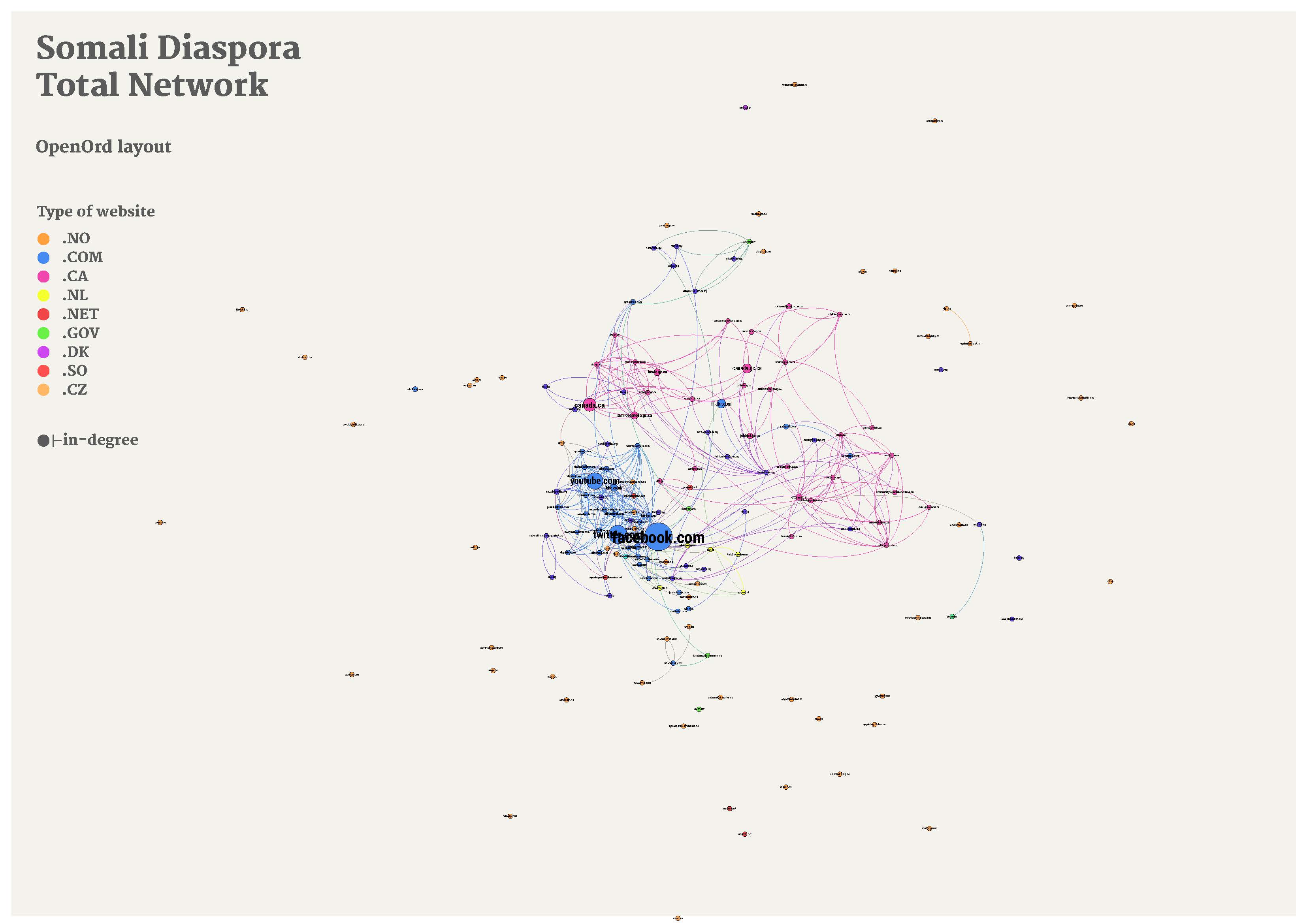 _Figure 1_
_Figure 1_
Findings: Facebook
61 Somali diaspora organizations are present on Facebook. Subsequently, an inter-page like analysis was performed through Netvizz and visualized in Gephi (see Figure 3). The total network (diaspora and non-diaspora) consisted of 615 organizations (nodes) and 2021 connections (edges). The Facebook pages cluster, provides a variety of diaspora geographies.The first of these geographies may be described as newly discovered hubs, as they do not match the clusters mentioned in the literature (see above). The U.S. clusters are based in Seattle, San Diego and Ohio, the Canadian in Ottawa. The U.K. clusters are located in Bristol as well as London. These hubs could be described as inward-looking, concerned mainly with integration, that is, with improving living conditions in the diaspora groups' current cities of residence. The exception is a cluster - the second discovered geography of the Somali diaspora - that combines a mix of London-based literary activity with worldwide movements oriented to uplifting Somali identity with the I am a star campaign, referring to the white star on the Somali flag, a campaing aiming at raising funds for Somalia through charity activities. During the course of the Facebook page collection work, pages based in Somalia were also located. They form a third geography as these pages primarily like (or link to) international and intergovernmental organizations forming an outward-looking, UN-focused cluster.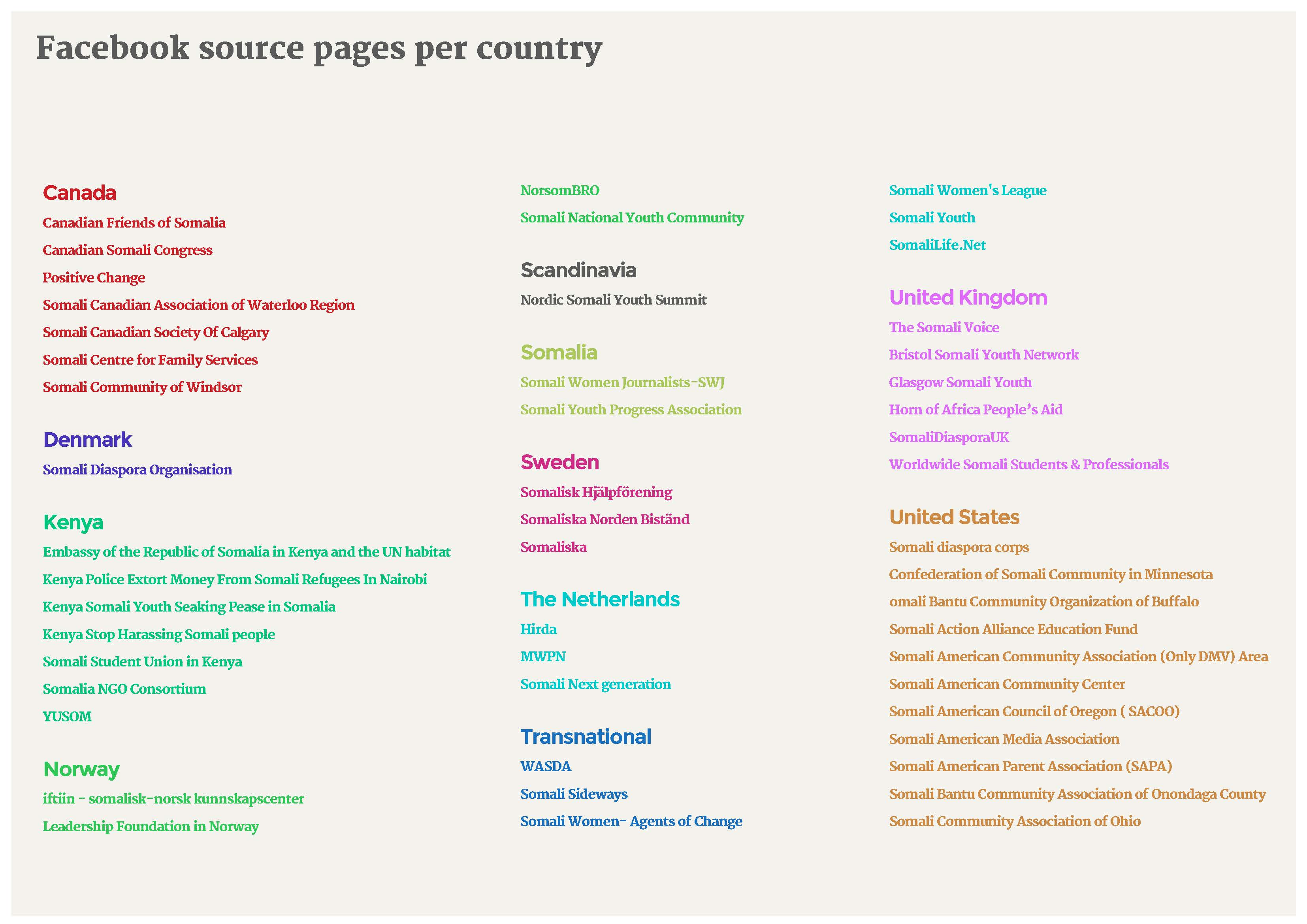 _Figure 2_
_Figure 2_
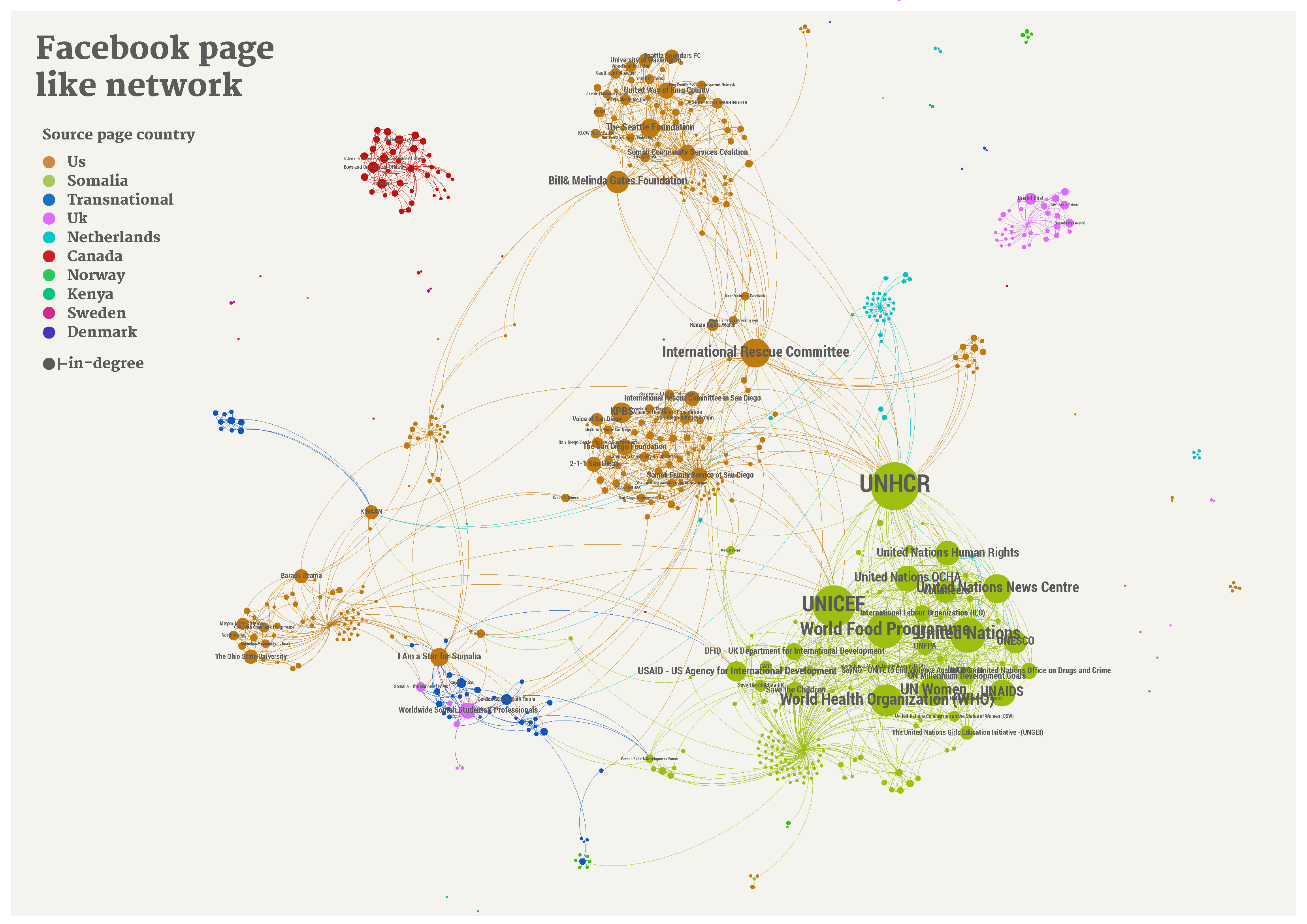 _Figure 3_
_Figure 3_
Case Study 2 - Rwanda
The second case study was devoted to the Rwandan diaspora. On 6 April 1994, the death of Juvénal Habyariman, president of Rwanda, and Cyprien Ntwaryamira, the Hutu President of Burundi, caused by a rocket attack ignited a period of intense and systematic massacre. Military and militia groups began rounding up and killing Tutsis, leading to the death of 1 million people, and around 100.000 people displaced (UN). According to the Global Forum of Migration and Development (GFMD), the Rwandan government is actively trying to connect and enhance ties with its diasporas. Resulting from a round table discussion at the GFMD, the following has been recommended. "Enhance links between diasporas and countries or origin, including over generations, through regular dialogue and information channels (formal or informal, political involvement) and provide accurate information to diasporas about development and investment opportunities in countries of origin" (GFMD 2007 2.4/3) [See more at: http://www.gfmd.org/pfp/ppd/15#sthash.EVkm45eu.dpuf]. This study has examined the Rwandan diaspora in the United States, Canada, Netherlands, United Kingdom, Belgium, France, Rwanda, Kenya, Switzerland. The following section presents the most significant results.Findings: Google
Figure 4 represents the overall Issue Crawler Rwandan diaspora network. There is a type of homeland calling visible, and Facebook appears to be the largest node - indicating a platform to study further. Figure 5 represents the Canadian Issue Crawler network, which appears to be dominated by governmental sites, or embassies, located in the Netherlands, Belgium, Switzerland, Rwanda and Kenya. Twitter is the largest node in the network.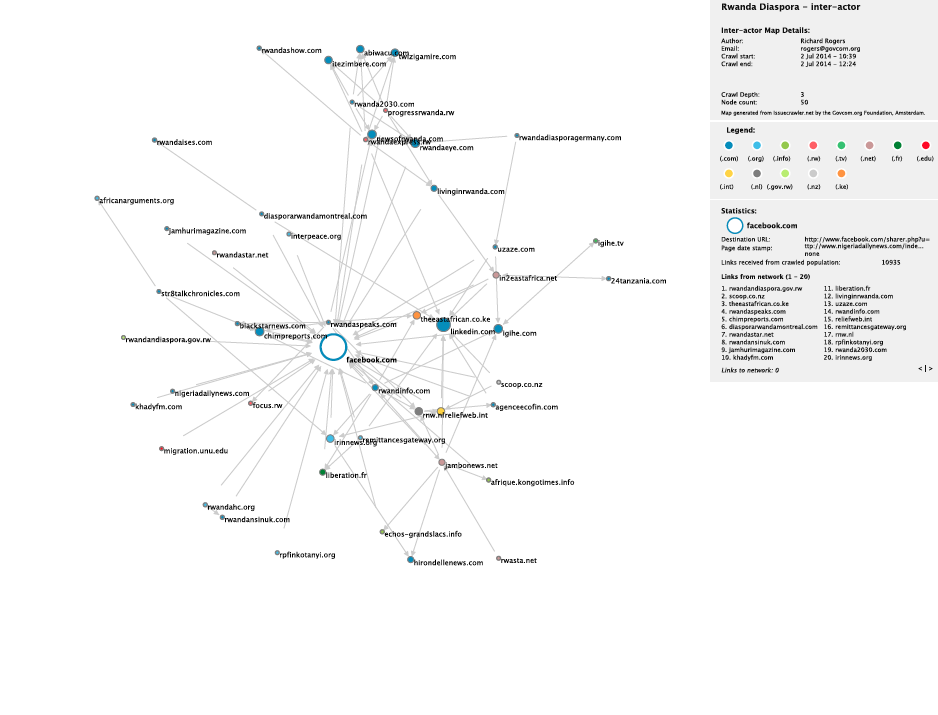 _Figure 4_
_Figure 4_
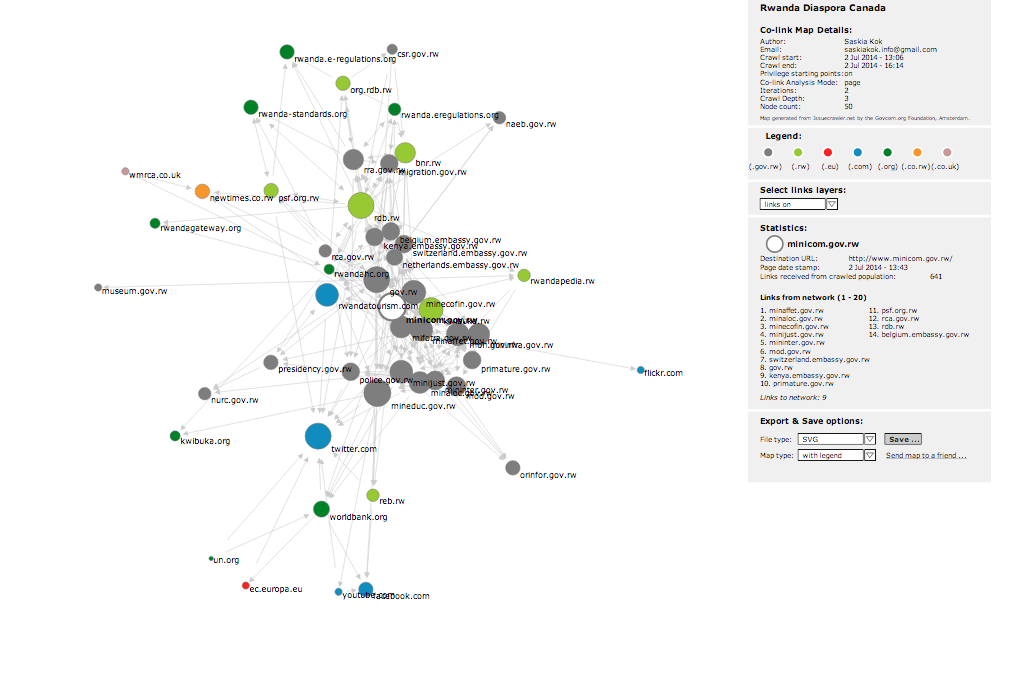 _Figure 5_
_Figure 5_
Findings: Facebook
Figure 6 represents the Rwanda diaspora Facebook page like network, showing most significantly a government- organized diaspora, revolving around the President and his Rwanda Day tours of diaspora, such as Brussels, Chicago, Boston and so on. There are different clusters visible where the UK, France and US link together, Rwanda and Canada, as well as some seperate clusters.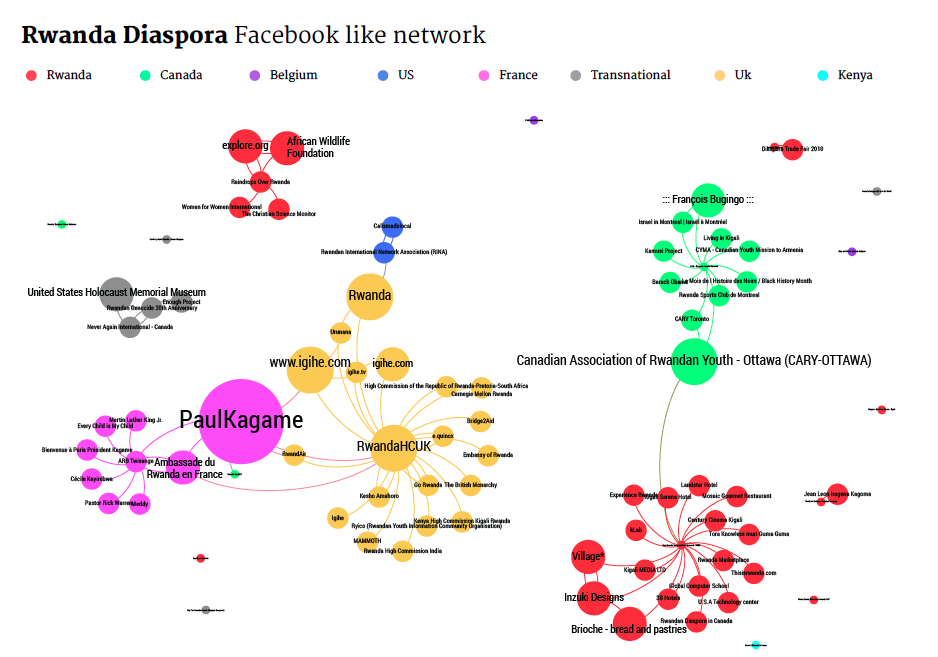 _Figure 6 _
_Figure 6 _
Comparative Findings [summary]
- Somali Diaspora in Canada: Facebook is the most significant node as well as local integration being the most important category of websites.
- Rwanda Diaspora overall and in Belgium: There is a type of homeland calling (or government organized diaspora) as well as Facebook being the significant node.
- Somalias inter-page network shows integration in the host countries as most important, where new significant host hubs emerge such as Ottowa, Bristol, Seattle, San Diego and Ohio (for further on the ground research).
- Comparatively, Rwandas inter-page network shows most significantly a government- organized diaspora, revolving around the President and his Rwanda Day tours of diaspora, such as Brussels, Chicago, Boston and so on.
Discussion
The project has studied diaspora geographies in three senses: the on-the-ground populations (available through the official numbers from e.g. the UN), the online networks on the web and in Facebook and, thirdly, the directionality of the diaspora calling, whether it is more homeland focused or primarily focused on integration into the new place of residence. The on-the-ground population figures provide the rationale for the (method of) study of Somali diasporas, e.g., visit the capital cities of the countries with high populations. We have taken this approach a step further. The diaspora country places have local search engines (local domain Googles) which may be queried for Somali diaspora groups, broadly conceived and more or less formalised. These groups, it was found, are largely not well linked online, showing loose cohesion, with Facebook and Twitter as larger nodes to be further explored. With regard to the Somali Diaspora, the Canadian network was the most cohesive and also showed websites that pointed to social integration (as opposed to a homeland calling orientation, or to an intergovernmental/international linkage). These findings served as clues to explore the online networks further, especially in Facebook, and also look into the directionality of the calling (homeland vs. host country). Thus, the subsequent Facebook analysis revealed a series of geographies. To reiterate: 1. The integration geography The integration geography points to US clusters, like San Diego, Seattle and Ohio (not Mineappolis as stated in the literature). In Britain, the cluster revolved around Bristol. In Canada, integration activities were most active in Ottowa. Hence, this finding suggests a new set of places, or hubs, to study further. 2. The UN geography The UN cluster revolves around Somalis in Somalia reaching out, not to Somali communities abroad but to UN intergovernmental organisations. 3. The Transnational Geography The (smaller) cluster that revolves around the I am a star campaign can be considered transnational, where Somalis abroad raise funds for the home country and strenghten Somali identity. This is the only distinctly transnational geography identified in this analysis, surprisingly enough, as diaspora groups are thought to be almost inherently transnational in character ( Adamson, 2012; Adamson & Demetrious, 2007; Kissau & Hunger, 2010). In contrary of the Somali diaspora, the Rwandans have stronger ties with the homeland. Diaspora activity is often characterized as follows: outreach with international organizations, use of mass media, and employment of potential allies to influence governments in their countries of origin and settlement. In addition, direct lobbying, use of traditional and new media campaigns, fundraising, lawsuits, demonstrations, electronic communication, and political participation prove successful when coupled with strategic implementation. However, through the use of the Issue Discovery tool a new (more specific) set of Rwandan diaspora activities are found. 1. Investment in homeland and the transfer of home remittances through Diaspora banking, diaspora bonds and other financial instruments. 2. Rwanda Day (and President touring the diaspora) - expressing unity as well as a governmental involvement in the diaspora. 3. Repatriation (including people in their thirties and returning politicians). 4. Commemoration of the genocide of 1994. As a note of caution it might be added that the extent to which the Somalis and Rwandans are online and on Facebook will most likely vary from country to country, possibly depending on how long the refugee group has resided in the host country. For example, the Somalis are a relatively new group in the Scandinavian countries, which was reflected in the fact that Facebook did not show up as a significant node in their country-based URL analysis. Furthermore, many of the identified Somali-Scandinavian organisations did not have actual websites but are evidently active in the local communities anyhow. These national differences naturally influence the results of a web-based analysis.| I | Attachment | Action | Size | Date | Who | Comment |
|---|---|---|---|---|---|---|
| |
Canada_most_engaging_content.jpg | manage | 712 K | 27 Jun 2014 - 15:12 | RichardRogers | Somali Diaspora on Facebook - Canada |
| |
Rwanda_Diaspora_Inter-Actor.pdf | manage | 236 K | 30 Sep 2014 - 13:16 | SaskiaKok | Rwanda Diaspora Inter-Actor |
| |
Rwanda_Facebook_Page_Like_Network.png | manage | 129 K | 30 Sep 2014 - 13:02 | SaskiaKok | Rwanda Facebook Like Network |
| |
Rwanda_Issue_Crawler_Canada.png | manage | 164 K | 30 Sep 2014 - 13:15 | SaskiaKok | Rwanda Issue Crawler Canada |
| |
Rwanda_Map_Inter-Actor.png | manage | 127 K | 30 Sep 2014 - 13:20 | SaskiaKok | Rwanda Diaspora Inter-Actor |
| |
Somali_Diaspora_Total_full_opneord.jpg | manage | 289 K | 30 Sep 2014 - 13:57 | SaskiaKok | |
| |
Somali_Diaspora_Total_full_opneord.pdf | manage | 229 K | 30 Sep 2014 - 09:31 | SaskiaKok | |
| |
facebook_seed_pages_list.jpg | manage | 382 K | 27 Jun 2014 - 14:55 | RichardRogers | Somali Diaspora on Facebook |
| |
size-indegree_color-sourcenation.pdf | manage | 1 MB | 27 Jun 2014 - 11:51 | RichardRogers | Somali Diaspora on Facebook |
| |
size-indegree_color-sourcenation_optimized.png | manage | 386 K | 27 Jun 2014 - 14:33 | RichardRogers | Somali Diaspora on Facebook |
Edit | Attach | Print version | History: r16 < r15 < r14 < r13 | Backlinks | View wiki text | Edit wiki text | More topic actions
Topic revision: r15 - 30 Sep 2014, SaskiaKok
 Copyright © by the contributing authors. All material on this collaboration platform is the property of the contributing authors.
Copyright © by the contributing authors. All material on this collaboration platform is the property of the contributing authors. Ideas, requests, problems regarding Foswiki? Send feedback


